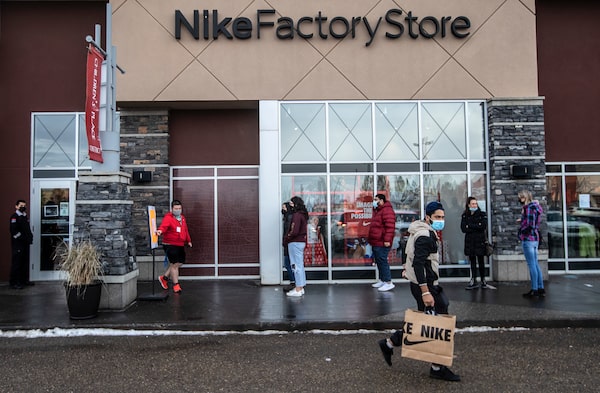
People line up to get into a Nike outlet during Black Friday in Edmonton, Nov. 26, 2021.JASON FRANSON/The Canadian Press
At stores across the country, holiday shoppers are on a mission.
Concerns over supply chain shortages have driven some people back to in-store shopping, a trend that was evident during the Black Friday sales that hit their peak this past weekend, said Bradley Jones, head of retail for Toronto-based Oxford Properties.
“They’re researching online and they’re coming to shop in the stores because they want the experience – but more importantly, they want to ensure that they have the product in their hands for the holiday,” Mr. Jones said.
For Oxford – which owns shopping centres including Yorkdale Mall in Toronto and Southcentre Mall in Calgary – overall traffic is still down between 10 and 20 per cent compared with 2019, depending on the location. But the average spend per visit is higher.
“You’re seeing a movement to shopping with purpose, with knowledge about the products they want,” he said.
While holiday sales promotions have been creeping earlier in the season for a number of years, Black Friday and the following weekend continues to be the busiest shopping period in the calendar for many retailers. This year’s shopping patterns indicate that the industry is on a path to recovery following the COVID-related declines in 2020, but uncertainty remains.
“We are not quite back to pre-COVID levels,” said Peter Goldsztajn, director of corporate data analytics for Moneris, which provides terminals that process debit and credit card payments for more than 350,000 merchant locations in Canada. The company estimates it processes roughly one-third of store transactions across the country.
Scotiabank hikes dividend 11% as profit rises on retail gains, improved loan picture
Moneris recorded 22.8 million transactions last Friday, roughly a 15-per-cent increase compared with 2020, when many shoppers turned to e-commerce amid pandemic-related restrictions and store closings in some areas. But the volumes are still below 2019 levels, when Moneris recorded roughly 24 million transactions.
“The general trend has been better. As you can see in Black Friday, people are still a little hesitant,” he said.
While Moneris did not share dollar figures for total sales, Mr. Goldsztajn noted a continuing trend of shoppers making fewer visits, but spending more at one time.
At Oxford-owned malls, retailers in the athletic and athleisure categories have been performing well, and Black Friday events at retailers including Lululemon and Aritzia drew traffic, Mr. Jones said.
Canadian e-commerce company Shopify Inc. noted that customers purchasing from retailers through its platforms spent more this year: the average cart price was nearly $150 from Black Friday through Cyber Monday, up from $133.63 in 2020, and a 56-per cent increase compared with 2019, said Solmaz Shahalizadeh, vice president of commerce intelligence at Shopify. The company also provides point-of-sale software for in-store merchants and has seen brick-and-mortar transactions increase this year.
“That’s a good sign for the economy, and a general sense that people are thinking about the holidays,” Ms. Shahalizadeh said.
But the shoppers who did come out for the big preholiday promotions this past week may not have found as many deals as in years past. Global supply chain woes have led to delayed shipments, increased freight costs, and higher prices for some materials, and the need to manage inventories has led some retailers to alter their promotional strategies. That means either offering fewer items for sale, promoting less steep discounts than in previous years, or offering sales on items whose prices may have already gone up.
“There were probably fewer discounts or smaller discounts than in previous years, because retailers aren’t having a full supply chain, so they’re feeling they don’t have to discount as much,” Oxford’s Mr. Jones said. “Retailers are doing their best to manage their inventory and manage the supply chain, and manage customer expectations given the logistics that they’re dealing with. … Their cost of goods is higher, and the cost of labour is higher, the cost of materials are higher. That’s putting pressure on retailers.”
Your time is valuable. Have the Top Business Headlines newsletter conveniently delivered to your inbox in the morning or evening. Sign up today.
 Susan Krashinsky Robertson
Susan Krashinsky Robertson